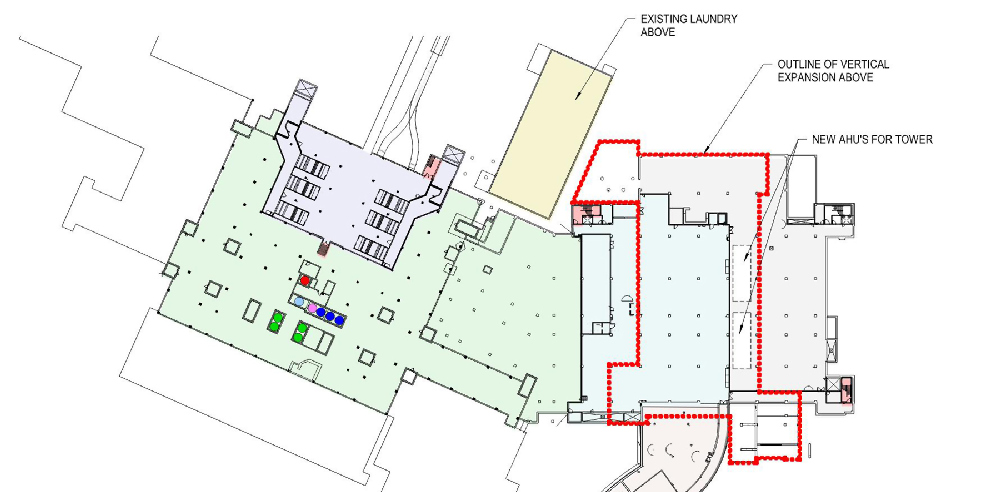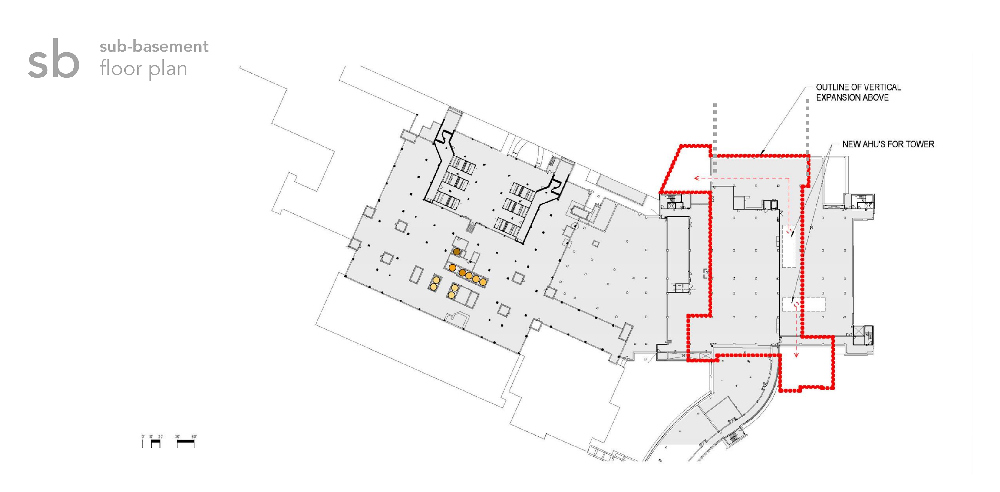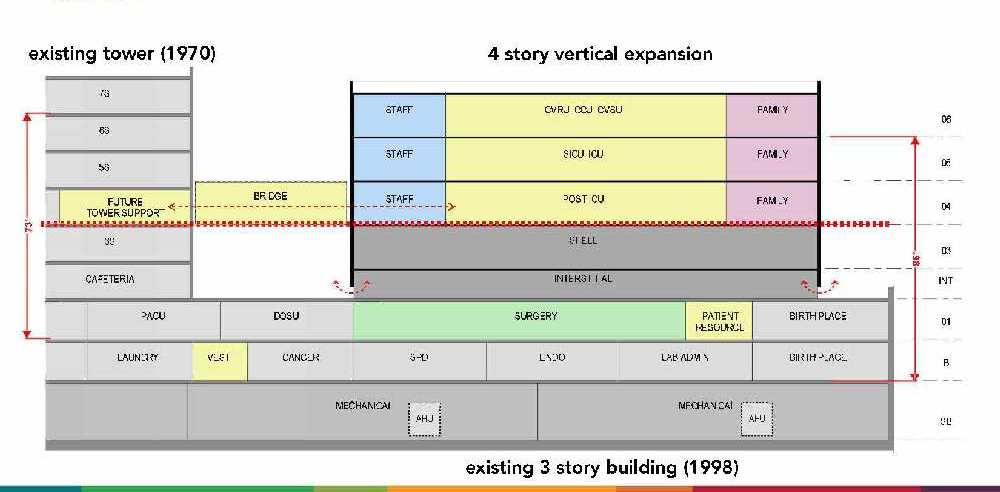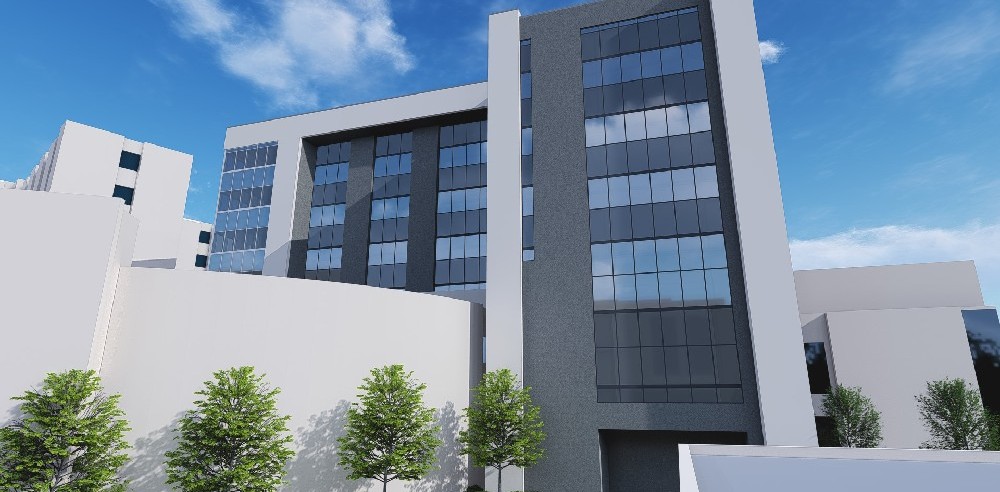 Vertical expansion plan.
Vertical expansion plan.  Outline of vertical expansion.
Outline of vertical expansion.  This diagram shows how interstitial spacing creates a barrier between actively used medical areas and floors under construction.
This diagram shows how interstitial spacing creates a barrier between actively used medical areas and floors under construction.  Aerial rendering.
Aerial rendering.  Vertical integration is an optimal way to expand a medical space without interfering with ongoing operations where land availability is limited.
Vertical integration is an optimal way to expand a medical space without interfering with ongoing operations where land availability is limited. Subscribe Now
Vertical Expansion Provides Built-in Opportunities for Future Planning
By Minta Ferguson
America’s healthcare systems are learning to adapt during a period of great disruption. The COVID-19 pandemic, combined with large aging and acute populations, have highlighted spatial limitations in even the most advanced and well-designed medical centers, creating pressure for healthcare systems to expand their facilities. However, shutting down operations for construction is rarely an option without temporary facilities and, thus, additional costs.
Vertical expansion — construction of additional levels on top of an existing building — might seem like a complicated way to build out new spaces, but it offers many advantages over horizontal expansion, which is the construction of freestanding buildings. While these can be highly complex projects, building skyward is often a cost-effective and less disruptive option for expanding a healthcare facility when compared to erecting an entirely new building.
With the United Nations ideating on solutions to land scarcity such as “floating cities” and billionaires contemplating developing outer space, we have a responsibility to manage our resources better. As demand for medical services grows in densely populated urban areas, hospital systems may not have access to nearby land for purchase, or may be seeking more budget-friendly alternatives to expand. Building on top of existing facilities eliminates the need for additional land and frees up more capital for the construction, itself.
In many cases, facilities that opt for vertical expansion may already have the necessary infrastructure designed into the original building. However, applying this type of construction in a building where that infrastructure isn’t present is still possible through innovative engineering and creative design solutions (but at an added cost). An added benefit to vertical expansion is that by the end of construction, the structure’s new rooftop can be designed to include infrastructure that allows the facility to add more levels down the road, should demand for services continue to increase.
When McMillan Pazdan Smith Architecture took on a project at CaroMont Regional Medical Center in Gastonia, North Carolina, architects laid out expansion options for the 435-bed independent hospital’s new critical care tower. Leadership could decide to take up more square footage by expanding onto the campus, or choose to go vertical. In this case, the original design for the southeast wing of the medical center included the required infrastructure for future vertical expansion, which eased engineering demands for building atop the high-rise. The decision to add four floors to the existing three-story building was made after considering several factors, including cost, space optimization, current structural design and patient and staff experience.
Prioritizing communication with occupants and minimizing disruption
Healthcare providers do not have the luxury of stopping patient care to make time for construction. Additionally, shutting down hospital sectors to make room for construction crews is not ideal, and can drastically impact patient care. Architecture teams will always need to bend to facility operations, and there are several ways that needs to happen in a medical setting.
Firms must take special considerations during renovation projects to avoid disturbing patient care. Since most of the work happens above day-to-day operations in this type of construction, the impact felt by those working and receiving treatment in the floors below can be drastically reduced with good planning and strong communication between architects, contractors and hospital staff.
To minimize disruptions, such as noisiness and structural vibrations, architects and engineers must work alongside the facility’s occupants to ensure the project operates smoothly. Since expanding the CaroMont Regional Medical Center’s critical care tower involved building floors above a surgical suite with multiple operating rooms, the McMillan Pazdan Smith team made sure to give physicians, nurses and other staff members a seat at the planning table and provided frequent project updates. Equipment and noise-reduction strategies were also used to help reduce disturbances.
Establishing a thorough logistics plan for containing construction impacts is a necessity, as is communicating the steps taken and reminding occupants that the end results will ultimately outweigh the inconveniences of a largescale expansion project. At CaroMont, the staff understood that the final product would grant the hospital twice the number of intensive care unit rooms it started with. That light at the end of the tunnel helped reduce frustrations and turned staff who might have been inconvenienced during construction into advocates for the project.
Some tactics employed for successful vertical expansion while operations remain ongoing can include:
- Level-by-level mechanical/AHU placement
- Integrating an interstitial level as a temporary or permanent buffer
- Designing existing structural systems for seamless future vertical connections
- Using roof anchors to move and install exterior products
- Utilization of insulated temporary roofing for noise mitigation
When vertical expansion is an option, there are additional considerations to include:
- Ability to meet life safety and egress requirements
- Impact to major infrastructure systems and equipment (CUP & utilities)
- Fire department access and high-rise construction requirements
- Seismic code changes, which could reduce the number of floors allowed or impact structural requirements
- Operations and access from ancillary services
- Integrating services and reducing travel within hospital walls
A significant advantage to building medical centers up, instead of out, is the opportunity it provides healthcare systems to consolidate various services in a single facility. Vertically integrated hospitals can offer patients a breadth of efficient care by relocating key services that work in tandem to be closer together. The wider a campus is, the more patients and staff have to travel to get from room to room and from service to service. Adding floor levels to a building can help maximize the available footprint, with elevators operating to significantly decrease travel distances across a medical campus. However, to maintain efficiency, existing elevators should be evaluated against the projected increased utilization to determine if more are needed.
As mentioned earlier, adding levels to a structure, particularly one that is already multiple stories tall, can present complicated engineering and design challenges. Healthcare design is demanding, and every detail needs to be scrutinized, including how the project will impact airflow, HVAC units, medical equipment and more. Mishandling even the most minor component could put the occupants of an operational medical center at risk. However, when executed correctly, a vertical expansion project can be beneficial to healthcare systems because operations won’t need to shut down, or drastically reduce operations, to accommodate construction.
Author: Minta Ferguson
Minta Ferguson, AIA, ACHA, NCARB, is the director of planning at McMillan Pazdan Smith Advisors. She can be reached at mferguson@mcmillanpazdansmith.com.
Tags: Construction, future planning, vertical expansion
Posted May 11, 2022
More Articles:
- Coverings 2024
Apr 22, 2024 – Apr 25, 2024 - Hospital, Outpatient Facilities & Medical Office Buildings Summit
Apr 25, 2024 – Apr 25, 2024 - CxA Workshop & Exam
Apr 29, 2024 – Apr 30, 2024 - EMP Seminar & Exam at CxEnergy 2024
Apr 29, 2024 – Apr 30, 2024 - CxEnergy
Apr 29, 2024 – May 2, 2024 - PHCC West 2024
Apr 29, 2024 – May 2, 2024 - Lean in Design Forum 2024
May 1, 2024 – May 2, 2024










